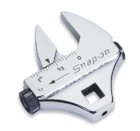My simple (but IMO very consistent!!) annealing process;
-I first do a gentle degrease using a room temperature mix of Methyl Ethyl Ketone and isopropyl Alcohol, ROUGH but gentle, this is the first degrease.
-Then a warming cycle, I've build machine that gradually rises temp 2 degrees per hour. I bring to 64*C and hold for 3hrs.
-Then a second and final degrease by soaking in straight MEK for 3-5 hrs thru the "cooldown period" bringing the cases back to ambient.
-A quick shake-out using a two-sided colander, roll/roll/roll, quickly but again, gently with a supple wrist motion.
-now were ready for the drying process.....
-I begin by standing the cases in 50rd milled AL loading blocks in an oven, a convection oven with gently swirling air (2 birds, 1 stone!)
-After 1hr in oven I run my hairdryer over the cases as I peer gently into all of them inspecting for traces of moisture.
-Next is the all important "final check of dryness".......
-My shop air is set at 180psi, this is a little hot as it tends to send cases bouncing around the room...... so I regulate it down to 165psi and stuff an air nozzle into each case mouth, spewing any residual MEK violently forth and scattering it widely. I do this inside a specially built box, a small room fabricated from repurposed freezer boxes which I line with reclaimed, green onion-skin paper (actually the "green" paper is white as it's triple-bleached after reclamation but you know what i mean lol)... the paper picks of traces of fluid which, viewed under ultraviolet light fluoresces brightly, the viewing under a black light trick is one I'm very proud of..... makes the whole process very exciting and CSI-like.......If ANY TRACE of liquid is present I go back to step one and start the drying process all over, life is TOO SHORT to have residual MEK in my cases!
-If I PASS, in other words if all the onion-skins pass under the fluoroscope without shining bluely I'm then ready to anneal.
-My annealer does 17 cases at a time, it's temperature controlled to the micro-degree and it runs the cases through a swirling mist of 68*F water droplets before dropping them into an agitated water bath regulated to 50*F (I use F for this because my WW thermometers are 'Murican, not foreign) I'm contemplating adding ultrasonic vibration to the agitation in an attempt at preventing the ever-present cavitation which occurs every rotation but this is future-speak as I'm currently under-funded so to speak.
-I don't feel a need to normalize the temperature of the cases going into the annealer since I've individual thermo-laser pickups on each of the 17 cases which feed into a software app which adjusts for each individual case with a true real-time feedback loop, graphing temperature flux and rise through the entire annealing cycle, any cases which arrive under or over mean soon achieve normality, long before any internal structural changes can occur. Avidly monitoring and recording/graphing these cycles on the array of 17 monitors is also very exciting and CSI-like, my third favorite part!
-I won't bore you with the details of the actual annealing cycle since we're all accomplished annealers here, peers as it were and this part is pretty repetitive and self-explanatory, nor will I share with you a representative sample of my graphing technique but suffice it to say, THANK YOU MS WORD!! Many a contented eve is spent perusing these graphs with a spirited beverage and soft baroque music......
-But, Back To The Business!
-Like others here, I do drop into a water bath after the comprehensive annealing process has completed and here is where it gets good!
-I Already Have A Drying Technique As Shown Above!!
-NOW the genius of my simple system becomes apparent! NO special tools, NO added steps, NO more processes because I've all the needed equipment already present and accounted for! I simply use THE SAME DRYING PROCESS AS WITH THE MEK!!
-But with the addition of a final gentle cleansing rinse after the agitation (and hopefully ultrasonic, soon!) cooling cycle.
Brilliant! The only difference is that now I must remember to add a fluorescing agent to my final rinse, easily done as I've fluorescing agents (dyes) I can readily whip up with "items normally found under the kitchen sink" as it were......
So then.....
NOT!!!!
I don't friggin' anneal! I don't even brush out my casemouths.....but that's how I WOULD do it
if I annealed











